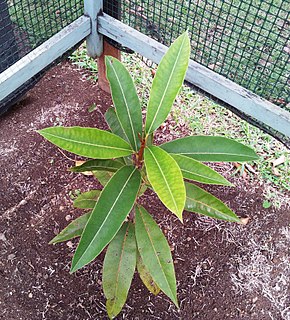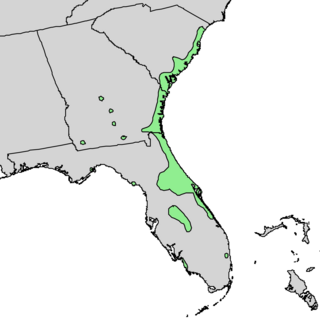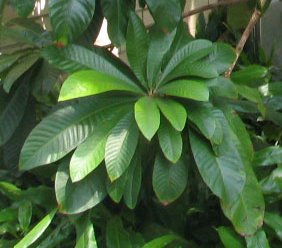This page is based on this
Wikipedia article Text is available under the
CC BY-SA 4.0 license; additional terms may apply.
Images, videos and audio are available under their respective licenses.

Sideroxylon grandiflorum, known as tambalacoque or dodo tree, is a long-lived tree in the family Sapotaceae, endemic to Mauritius. It is valued for its timber.
Ironwood is a common name for a large number of woods or plants that have a reputation for hardness, or specifically a wood density that is over 1000 kg/m3 and sinks in water. Usage of the name ironwood in English may include the tree that yields this heavy wood.

Eucalyptus sideroxylon, or mugga, red ironbark or mugga ironbark, is a small to medium-sized or occasionally tall tree that is found throughout eastern Australia.

Sideroxylon is a genus of trees in the family Sapotaceae described as a genus by Linnaeus in 1753. They are collectively known as bully trees. The generic name is derived from the Greek words σιδηρος (sideros), meaning "iron", and ξύλον (xylon), meaning "wood."

Sideroxylon lanuginosum is a shrub or small tree of the family Sapotaceae. It is native to the Sun Belt and Midwest of the United States as well as Northeastern Mexico. Common names include gum bully, black haw, chittamwood, chittimwood, shittamwood, false buckthorn, gum bumelia, gum elastic, gum woolybucket, woolybucket bumelia, wooly buckthorn, wooly bumelia, ironwood and coma.
Sideroxylon acunae is a species of plant in the family Sapotaceae. It is endemic to Cuba.
Sideroxylon bullatum is a species of plant in the family Sapotaceae. It is endemic to Jamaica. It is threatened by habitat loss.
Sideroxylon confertum is a species of plant in the Sapotaceae family. It is endemic to Cuba. It is threatened by habitat loss.
Sideroxylon fimbriatum is a species of plant in the family Sapotaceae. It is endemic to Yemen. Its natural habitat is subtropical or tropical dry forests.

Sideroxylon mirmulans is a species of flowering plants in the family Sapotaceae. It is endemic to the Madeira Islands (Portugal). It is threatened by habitat loss.
Sideroxylon montanum is a species of plant in the family Sapotaceae. It is endemic to Jamaica. It is threatened by habitat loss.
Sideroxylon peninsulare is a species of plant in the family Sapotaceae. It is endemic to two spots on the southern end of the Mexican state of Baja California Sur.
Sideroxylon rubiginosum is a species of plant in the family Sapotaceae. It is endemic to the Dominican Republic.
Sideroxylon stevensonii is a species of plant in the family Sapotaceae. It is found in Belize and Guatemala.
Sideroxylon salicifolium, commonly called white bully or willow bustic, is a species of flowering plant native to Florida, the West Indies and Central America. It has also been considered a member of the genus Dipholis, with the binomial Dipholis salicifolia. Its specific epithet is derived from the Latin salix 'willow' and folia 'leaf'.

Sideroxylon celastrinum is a species of flowering plant in the family Sapotaceae, that is native to Texas and Florida in the United States south through Central America to northern Venezuela and Colombia in South America. Common names include saffron plum and coma. It is a spiny shrub or small tree that reaches a height of 2–9 m (6.6–29.5 ft). The dark green leaves are alternate or fascicled at the nodes and oblanceolate to obovate. Greenish-white flowers are present from May to November and are followed by single-seeded, blue-black drupes.
Sideroxylon foetidissimum, commonly known as false mastic or yellow mastic, is a species of flowering plant in the family Sapotaceae. It is native to Florida in the United States, the Caribbean, and northern Central America.

Sideroxylon inerme is a Southern African coastal tree, with dense foliage, black berries and small, foetid, greenish flowers. The tree's generic name means "Iron-wood" in Greek, referring to its very hard timber.
Sideroxylon majus is a long-lived tree in the family Sapotaceae, endemic to Réunion.

Sideroxylon tenax, called the tough bully, is a plant species native to Florida, Georgia, South Carolina and the southernmost part of North Carolina. It grows on dry, sandy soil in pine forests, pine-oak woodlands, and hummocks at elevations less than 100 m.











